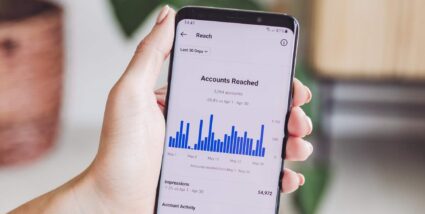Facebook might be bigger, and TikTok may have cultural clout—but for a lot of brands, Instagram is still where their advertising dollars count the most. And while Instagram gives brands built-in tools to understand how content is performing, it still takes some work to understand what’s actually going on.
You’re probably familiar with the terms reach and impressions. These terms are used in almost every discussion about Instagram advertising, but they get mis-used almost as often. These stats are even sometimes called vanity metrics, which they’re most certainly not.
We’re setting the record straight on what Instagram reach and impressions mean and how you can interpret these numbers to get the most out of your social strategy.
What is Instagram reach?
Reach is one of the most important Instagram metrics and also one of the most misunderstood. Here’s what you need to know.
Instagram reach defined
Simply put, reach is the number of unique users who saw your content. If the same user sees the content multiple times, they’re only counted as one account reached. Even if they view the same content in multiple placements (such as in stories and Reels), you’ll still only see your reach tick up by one.
Why Instagram reach matters
Reach is currently the most useful metric for measuring the total size of your audience on Instagram.
For a lot of brands, reach is most important as a proxy for their content’s organic discoverability: basically, how much the Instagram algorithm likes the content and how likely it is to recommend it to other users. Well-optimized content gets recommended more often, as does content that users interact with a lot.
The other important contributing factor to reach is how often your content gets shared from one user to another. When someone sends their friend your Reel, your reach ticks up by one as soon as they open it—or by three, four, or even more if they dropped it in the group chat.
One more thing you should know about reach: Instagram divides this metric into followers and non-followers. While we all love having lots of followers, a lot of non-followers seeing your content is generally how you grow your presence and increase organic discoverability.

Source: SimplyGram
What are Instagram impressions?
Instagram impressions are reach’s less-glamorous–but still hard-working–cousin.
Instagram impressions defined
Impressions reflect the total number of times your content was shown on a user’s screen. That means if the same user sees your content multiple times, it will count for a new impression each time. An impression still registers even if a user scrolls past your ad or doesn’t engage with it—all the ad has to do is show up.
Why Instagram impressions matter
Impressions measure how often your content is displayed, which makes them especially important for evaluating the performance of your paid ad placements on Instagram. If your total impressions are low, your targeting might be off, or your spend might be too low (if it’s a paid ad). If you’re getting a lot of impressions but your engagement is low, your ad creative might need some tweaks to make it more engaging.
Note: As of April 2025, organic impressions have been deprecated by Meta and replaced with the Views metric. This metric is similar to impressions, but encompasses a wider range of organic content, including Reels and stories. Impressions from paid ads are still available through Meta Ads Manager.
Instagram reach vs impressions: What’s the difference?
So what separates these two metrics, and which should you be paying the most attention to? It all depends on which questions you’re looking to answer.
Unique viewers vs total views
Reach shows you how many individual accounts viewed your content, while impressions shows how many times your ads appeared. In other words, reach is about users (or at least accounts), while impressions show you total views. One user seeing the same post three times will thus give you one reach and three impressions.
Audience size vs message frequency
Reach gives you a clearer idea of how many people are in your Instagram audience. It’s not a perfect yardstick, but it shows you approximately how many individual users you’re reaching. Impressions are more about how frequently your message appears, which is especially important for certain kinds of promotions that benefit from repeated messaging, such as big sales events.
Broad awareness vs repeated exposure
Do you want to spread the word far and wide, or do you want to hammer the point home? It’s okay if you need your campaign to go both wide and deep—but you should know which metric is telling you what.
Instagram reach vs impressions: When to prioritize each metric?
Instagram reach: for awareness and audience growth
Reach is primarily (but not exclusively) a top-funnel metric that measures how successfully you’re bringing your message to new customers. Reach would likely be one of your most important KPIs in situations like:
- Customer acquisition initiatives
- Product launches
- Rebranding
- Brand awareness initiatives
Instagram impressions: for reinforcement and retargeting
Impressions tend to be most important for mid- and lower-funnel content. At these stages, repetition is one of your major tools for giving customers a friendly nudge toward converting. Impressions are also something you should always check when monitoring an Instagram retargeting campaign—after all, the whole idea is “hey, remember this?”
Impressions often count the most when your goals are along the lines of:
- Retargeting and remarketing campaigns
- Major promotions
- Nurture campaigns for low-funnel audiences
- Campaigns with multiple posts in sequence
Reach and impressions: for full-funnel insight
For a truly holistic picture of your Instagram presence, you need to understand reach and impressions. Taken together, the two help you understand how your campaigns are doing and how individual posts are contributing to your brand presence.
If you’re looking for this kind of big-picture analysis, you’ll also definitely want to look at Instagram engagement, which shows you how often your followers like and share your content.
How to track and interpret these metrics
Alright, but where does all this stuff live, and how do you make sense of it? Glad you asked!
Where to find the data
You can look at both reach and impressions through your Instagram Insights dashboard. How do you get there? Honestly, Instagram changes this kind of stuff all the time, so we’re just going to direct you to the Instagram Help Center page that shows you how. That’s called “evergreen content,” folks.
If you’re looking for reach and impressions data on your paid ads, just head over to Meta Ads Manager.
Interpreting trends over time
You can also look at your reach and impressions data from up to three months prior and see whether you’re trending up or down. Some common scenarios that you might see include:
- Growth in reach: Keep it up—you’re creating engaging content that Instagram is recommending.
- Growth in impressions: Your content is showing up more often, whether that’s because of user interest, optimized content, or an algorithm change.
- Growth in impressions, but not reach: Your content is being shown to the same users again and again. Optimizing your content to be more discoverable and shareable can help.
To wrap it up (deep breath): Instagram Insights shows you both reach, or the total number of unique accounts that saw your post, and impressions, the total number of times your post appeared. Which one matters more depends on your campaign goals, but ultimately, both are important and worth tracking.
Need a little help figuring all that out? We get it. Instagram marketing is complicated, and it changes all the time—so a little assistance from a content marketing agency can go a long way.







Responses